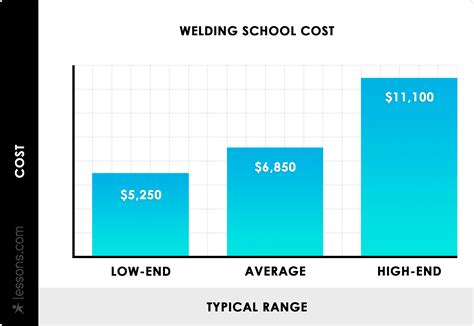Introduction

Welding is a skilled trade that is in high demand across a wide range of industries. As a result, welding schools can be a great option for individuals looking to enter a well-paying and stable career. However, the cost of welding school can vary significantly depending on the school, location, and program length. This article will provide a comprehensive overview of welding school costs, including tuition, fees, and other expenses.
Factors that Affect Welding School Cost
The cost of welding school can be influenced by a number of factors, including:
- School type: Public schools are typically less expensive than private schools.
- Location: Schools in major cities tend to be more expensive than schools in rural areas.
- Program length: Shorter programs are typically less expensive than longer programs.
- Program type: Some schools offer specialized programs, such as underwater welding or pipefitting, which may cost more than general welding programs.
Average Welding School Cost
According to the American Welding Society (AWS), the average cost of tuition for a welding program is between $10,000 and $30,000. However, the total cost of welding school can be significantly higher, depending on the factors listed above.
Tuition Costs
Tuition costs vary widely depending on the school and program type. Public schools typically charge lower tuition rates than private schools. For example, the average tuition cost for a welding program at a public community college is around $5,000, while the average tuition cost for a welding program at a private trade school is around $15,000.
Fees
In addition to tuition, welding schools also charge a variety of fees. These fees can include:
- Application fees: Application fees are non-refundable fees that are typically charged to cover the cost of processing an application.
- Registration fees: Registration fees are charged to cover the cost of registering for classes.
- Lab fees: Lab fees are charged to cover the cost of using equipment and materials in the welding lab.
- Equipment fees: Equipment fees are charged to cover the cost of using specialized equipment, such as welding machines or cutting torches.
Other Expenses
In addition to tuition and fees, welding students may also incur other expenses, such as:
- Books and supplies: Welding students typically need to purchase textbooks, welding rods, and other supplies.
- Transportation: Welding students may need to pay for transportation to and from school.
- Tools: Welding students may need to purchase their own tools, such as welding helmets, gloves, and pliers.
Estimated Total Cost of Welding School
The estimated total cost of welding school can vary significantly depending on the factors listed above. However, a general estimate of the total cost of welding school is between $15,000 and $40,000.
Financial Aid for Welding School
There are a number of financial aid options available to help students pay for welding school. These options include:
- Grants: Grants are free money that does not need to be repaid. There are a number of government and private grants available to welding students.
- Scholarships: Scholarships are awards that are based on merit or financial need. There are a number of welding schools and organizations that offer scholarships to welding students.
- Loans: Loans are money that students borrow and must repay with interest. There are a number of government and private loans available to welding students.
Tips for Saving Money on Welding School
There are a number of ways to save money on welding school. These tips include:
- Attending a public school: Public schools typically charge lower tuition rates than private schools.
- Applying for financial aid: There are a number of financial aid options available to help students pay for welding school.
- Buying used tools and supplies: Welding students can save money by buying used tools and supplies.
- Working part-time: Welding students can work part-time to help pay for school expenses.
Conclusion
Welding school can be a great option for individuals looking to enter a well-paying and stable career. However, the cost of welding school can vary significantly depending on the school, location, and program length. By understanding the factors that affect welding school cost, students can make informed decisions about their education and financial aid options.
Additional Resources
- American Welding Society: https://www.aws.org/
- Welding Schools & Programs: https://www.weldingschools.com/
- Financial Aid for Welding Students: https://www.finaid.org/loans/welding.phtml
| School Type | Average Tuition Cost |
|---|---|
| Public Community College | $5,000 |
| Private Trade School | $15,000 |
| Fee Type | Average Cost |
|---|---|
| Application Fee | $50-$100 |
| Registration Fee | $50-$100 |
| Lab Fee | $100-$200 |
| Equipment Fee | $50-$100 |
| School Type | Program Length | Estimated Cost |
|---|---|---|
| Public Community College | 1 year | $15,000-$20,000 |
| Private Trade School | 2 years | $25,000-$40,000 |
| Tip | Description |
|---|---|
| Attend a public school | Public schools typically charge lower tuition rates than private schools. |
| Apply for financial aid | There are a number of financial aid options available to help students pay for welding school. |
| Buy used tools and supplies | Welding students can save money by buying used tools and supplies. |
| Work part-time | Welding students can work part-time to help pay for school expenses. |
